|
FAQs on Sponge Identification
2
Related Articles: Sponges in Marine
Aquariums
Related FAQs: Sponge ID 1, Sponge ID 3, Sponge ID 4, Sponge ID
4, Sponge ID
5, Sponge ID 6, Sponge ID 7, Sponge ID
8, Sponge ID 9, Sponge ID 10, Sponge ID 11, Sponge ID 12, Sponge ID 13, Sponge ID 14, Sponge ID 15, Sponge ID 16, Sponge ID 17, Sponge ID
18, Sponge ID 19,
Sponge ID 20, Sponge ID 21,
& Sponges 1, Sponges
2, Sponges 3, Sponge Selection, Sponge Compatibility, Sponge Systems, Sponge Feeding, Sponge Disease, Sponge Reproduction,
|
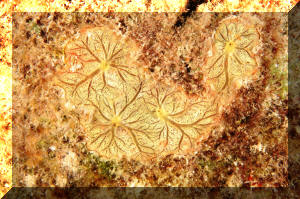
|
|
Sponge ID 4/18/4 Could you please identify the olive
colored growth that has been surrounding my Bali Xenia in these
photos. <it is a sponge... and its presence is not wholly a
problem at all. Enjoyable for many> It seem to be growing fast
- spreading over the LR. <as a voracious filter feeder... its
success is an indication of possibly heavy dissolved organics in
the system (heavy fish or feeding load, lack of adequate water
changes, lack of aggressive skimming, etc)> It now seems to
growing upward towards the light. The Bali seems to trying to
move away from it. It definitely is surrounding the base of the
xenia. What do you think it is and should I pick off the LR?
<better to starve such growths into control/submission by
getting at the root cause: nutrient control. But do
prune it in the meantime. Anthony>
|
|
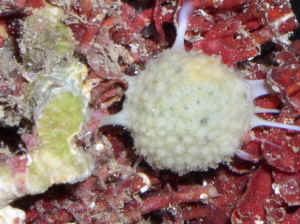
|
Identification of anemone and
sponge? 2/27/04 These pictures were taken in St. Croix last
weekend, <Mmmmm... sounds nice> I think that one
is a sun anemone, but it was NOT blue green in color as is advised
in my Reef Creatures book. <no matter... variable
color, and it really looks like Stichodactyla helianthus to me too.
The other is obviously an orange sponge of some kind... but what
kind exactly is it? <the possibilities are staggering. No way of
telling here my friend from a photo> I have non dumbed down
pictures if you want them. thanks Melissa Dickens
<best regards, Anthony> |
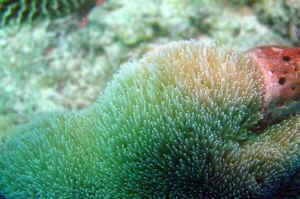 |
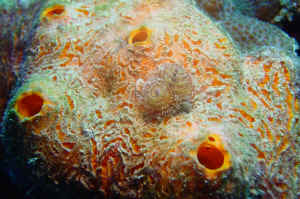 |
Growth ID - sponge 2/24/04 Could someone
tell me what this rose-colored growth is? <it
appears to be a sponge> It is spreading onto various pieces of
my live rock. It is actually not quite as orange-y
colored in real life. It's more of a mauve color and
more closely matches the color of the lavender
coralline. When I see a new "spot" of it on a
new piece of rock, it is an area with well-defined boundaries that
grows larger and larger (as opposed to something like an algae or
brown diatoms that get darker and darker within a whole area as it
grows). It is slippery to the touch, and leaves my
finger feeling slimy after I touch it, but no color rubs
off. I want to know whether to be concerned and to take
action to get rid of it, or to leave it alone. I
can't decide if it might be a cyanoBACTERIA or sponge or what?!
<the latter almost certainly. Steve Tyree of
Dynamicecomorphology.com has written a very detailed book on
sponges if you care to pursue it> Thanks so much for your time!
Bess
<best regards, Anthony> |
|
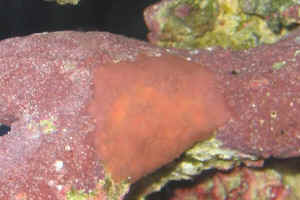
|
| Sponge ID II 2/25/04 One more quick
question, Anthony... Would you think sponge or tunicate since
it's slippery? <I still think its a sponge... do
check our chapters and comparisons of Tunicates vs. Sponges in our
"Reef Invertebrates" book> I know there is no way for
you to know for sure, but I'm just curious about your
guess. <actually... they are easy to ID. Look close
and you may see incurrent and excurrent pores... "cilia"
or not around the excurrent openings, etc> And thanks for the
suggestion about Steve Tyree - I'll check out his book. Thanks
so much, Bess <yes... a very dry but informative (packed) read.
Anthony> |
Sponge Identity First I want to thank you
for taking the time you devote to assisting to us wanna
bes. You have probably saved countless amount of life by
sharing your knowledge. Question, I recently purchased three
sponges for my 55 gallon tank. I have reviewed all I could find on
your site and have tentatively identified two of the
three. Would you please take a look and let me know if I
am correct. One of them I could not identify. Pic
100_0277 Yellow Ball Sponge i.e. Cinachyra spp. Pic 100_0275 Blue
Sponge i.e. Haliclona Blue <These two we are in
agreement on> Pic 100_0276 Red Sponge i.e. identity unknown
<Am not so sure about either. Maybe a Monanchora or Ageles
species. Did your supplier give you an idea of where it was
collected?> All of the new items appear to be doing
well. I do have a concern about the blue
sponge. This thing is literally growing before my
eyes. Will this take over my
tank? <Not likely. Almost always either "something"
becomes rate-limiting to their growth/expansion, they
"self-regulate", likely by some sort of chemical feedback
loop, or end up dying...> After I acclimated them to my tank,
there was a small piece that had apparently got broken off during
the transportation. So I thought to myself, what the
heck. So I just dumped it in the tank
also. Now, this is beginning to grow also. I
thought I might let it grow for a while and then trade it back to
my retailer for something else. <Good plan> Tankmates include
a yellow tang, coral beauty, lawnmower blenny, feather duster,
flame scallop, a few snails and crabs. I have studied
your site about your concern regarding the scallop after I had
purchased it. This will not happen again. I
have had mine for about four months and appears to be doing
well. I hope it continues. <Me too>
Second question, I am planning to upgrade my lighting soon to two
48 inch VHO's. One full spectrum and one actinic
blue. I will then take my current light strip and add
two 24 inch VHO's for a total of about 300 watts. My
wife is wanting to get an anemone. Do you think this
should be adequate lighting? <Likely so, though still not easily
kept. Do study up, learn how to pick out an initially healthy
individual, better species... perhaps a tank "bred" clone
of a Bubble Tip?> Thanks
Dean
<Be chatting, Bob Fenner> |
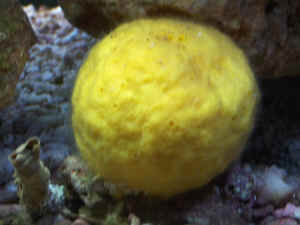 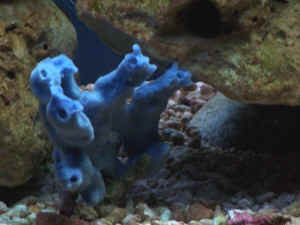 |
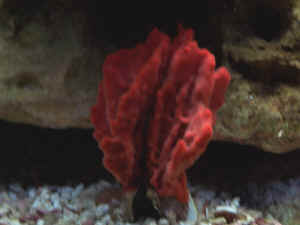 |
| Sponge ID Dear WWM Crew, Can you help make
an ID of this assumed sponge? I'm attaching a jpg
for your review. Any associated problems with this
animal? <A nice growth of (white) Syconoid sponges. Sign of a
healthy, stable system. No worries> Thanks for your web site and
help, Brian in Alaska <Thank you for sending this along. Bob
Fenner> |
|
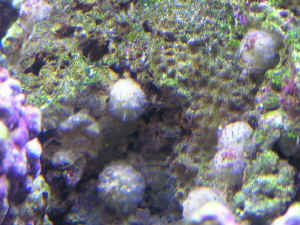
|
| Syconoid sponges of the genus Sycon 7/10/03
Hello I'm new to this whole thing, anyway I have a 29 gal salt
water with just crabs, 25 lbs of live rock, feather dusters, a
couple of snails, a mushroom coral (small), and these on the side
of my tank... What are they? Thank you for your time <these
critters are very common and commonly misidentified or
"unknown" incidentals that develops in marine aquaria
with live rock. They are Syconoid sponges of the genus Sycon.
Filter-feeders... harmless, and even desirable. They can reach
plague proportions if the tank is neglected or has other nutrient
control issues. Else no worries... enjoy! Kind regards,
Anthony> |
| Sponge ID - 9/30/03 Crew: Hey, I finally
got a picture of my tiny sponge that came on LR. <Sorry for the
delay. This email has moved about a few times before I received
it.> I hope it looks clear enough to identify.
<Not really> The "debris" on it did not
come off when I blew a powerhead on it. <Try a turkey baster at
an angle so as to not to push the debris further "into"
the sponge> It has a similar opening on the other
end. I am hoping to help sustain the life of this
organism, and I know identification is the first
step. So, any ID? <Unfortunately no. Too hard from a
picture, to tell you the truth. Harder than corals as there are a
great many similar sponges out there. What part of the world is the
live rock from? This might help narrow down the search to at least
a region to start. Sorry for the lack of an answer -Paul>
Thanks, Rich |
|
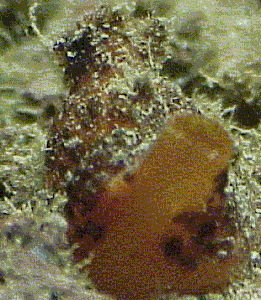
|
|
|

